 RDL Homepage |
 Table of Contents |
 Document Information |
 Download Instructions |
 RDL Homepage |
 Table of Contents |
 Document Information |
 Download Instructions |
The I/R facility commander provides guidance to all MP guard forces in the appropriate use of force to protect internees and internment facilities and to control unruly and rebellious internee populations. This includes establishing uniform procedures that govern the use of force, weapons, and restraining devices. He ensures that a QRF is organized and trained to respond to disturbances inside and outside the facility—whether prisoners are creating a disturbance or there is a Level I threat against the facility. Supporting MP units train squad- to platoon-sized QRFs and squad-sized elements for extraction and apprehension teams. (See FM 19-15 for more information on civil disturbances.)
B-1. When force is necessary, use it according to the priorities of force and limit it to the minimum degree necessary. (See AR 190-14 for the use of deadly force.) The application of any or all of the priorities of force, or the application of a higher numbered priority without first employing a lower numbered one, depends on and will be consistent with the situation encountered. Per AR 190-47, the priorities of force are—
B-2. The I/R commander coordinates with the higher echelon commander and the SJA. He designates representatives who are authorized to direct the use of firearms and riot control agents during riots or disturbances. He includes the rules for using these means in appropriate plans, orders, SOPs, and instructions. He specifies the types of weapons to be used, which are not limited to shotguns and pistols for guarding prisoners.
B-3. Deadly force causes death or serious bodily harm. It is a destructive physical force against a person using a weapon or equipment that exerts deadly force. Use deadly force in extreme situations, when all lesser means have failed or cannot be used reasonably. Deadly force is authorized for the following reasons:
NOTE: See AR 190-14 for more information on the use of deadly force.
B-4. The I/R facility commander ensures that soldiers understand the ROE, including the use of the term halt , the use of deadly force, and the ban on using physical or imaginary deadlines. He also ensures that EPWs and RPs understand the meaning of the English word halt .
B-5. When a prisoner tries to escape, the guard shouts HALT three times. He then uses the least amount of force necessary to stop the escape. If there is no other effective means of preventing escape, deadly force can be used. Do not fire on a prisoner unless he has cleared the outside fence (barrier, concertina wire, or razor tape) and is making a further effort to escape. Do not fire on a prisoner attempting to escape outside a fenced enclosure unless he does not halt after the third command. An escape is successful if a prisoner—
B-6. Commanders balance the physical security of forces with mission accomplishment and the ROE issued for the mission. The unified commander develops ROE for his forces. They are based on guidance from the national command authority; operational, political, diplomatic, and legal considerations; mission requirements; threat assessments; the law of land warfare; and HN or third-country constraints on deployed forces.
B-7. The political situation may influence the ROE and conflict with physical-security needs. In these cases, commanders weigh the political gains against the risk to the force. They clearly state their objectives with defined operational limits that allow mission accomplishment and protect deployed forces.
B-8. Restrictions on combat operations and the use of force are clearly explained in the ROE and understood and obeyed at all levels. Soldiers study and train in the use of the ROE and discuss the ROE for their mission. Misunderstandings and actions, no matter how minor, may have far-reaching repercussions because friendly and enemy media can exploit incidents rapidly.
B-9. The ROE address specific distinctions between internee categories and the instruments of control available for each. Use the following issues to develop guidelines:
B-10. The DOD defines NLWs as weapons that are explicitly designed and primarily employed to incapacitate personnel or material, while minimizing fatalities, permanent injury to personnel, and undesired damage to property and the environment. Unlike conventional weapons that destroy their targets through blast, penetration, and fragmentation, NLWs employ other means to prevent the target from functioning.
B-11. The NLW doctrine and concepts of operation are designed to reinforce deterrence and expand the range of options available to commanders. They enhance the capability of US forces to accomplish the following objectives:
B-12. The zero probability of producing fatalities or permanent injuries is not a requirement of NLWs. Complete avoidance of these effects is not guaranteed or expected; however, NLWs significantly reduce them as compared to lethal weapons. When drafting the ROE, clearly articulate that using NLWs is an additional means of employing force for the particular purpose of limiting the probability of death or serious injury to noncombatants or belligerents. However, the use of deadly force is an inherent right of individuals when they, their fellow soldiers, or personnel in their charge are threatened with death or serious bodily harm. The use of NLWs adds flexibility when controlling disturbances in an I/R facility by providing an environment where guard forces can permissively engage threatening targets with limited risk of noncombatant casualties and collateral damage (see FM 90-40). Table B-1 shows lethal, nonlethal, and ineffective zones of NLWs.
Table B-1. Range of NLWs
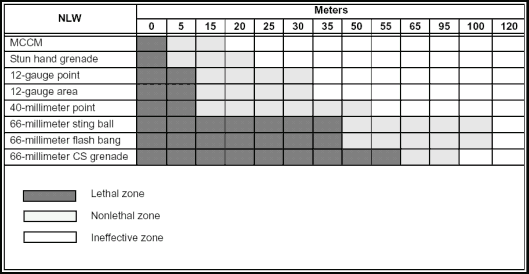
B-13. The use of lethal force under the standing ROE is never denied. Never deploy forces without giving them the ability to defend themselves against a lethal threat. Ensure that they are trained, armed, and equipped for combat. Nonlethal force is a complement to, not a replacement for, lethal force. Expand a proactive response across the range of military operations. Delegate the decision to use NLWs against an adversary during a confrontation to the lowest possible level, preferably to the platoon or the squad. Ensure that all personnel, not just leaders, have a clear understanding of the ROE and the commander's intent (see FM 90-40).
B-14. Facility commanders consider the use-of-force options discussed in this appendix and AR 190-14 when dealing with disruptions. They substitute nonlethal devices for firearms when they are adequate for MP to safely perform their duties. Currently, MP have the following nonlethal options available for crowd control:
B-15. Commanders and public affairs officers are prepared to address media questions and concerns regarding the use and role of NLWs. They make it clear that the presence of NLWs in no way indicates abandoning the option to employ deadly force in appropriate circumstances.
B-16. The NLWs provide the flexibility to favorably influence a situation with reduced risk of noncombatant fatalities and collateral damage. They are more humane, which is consistent with the political and social intent of humanitarian and peacekeeping missions. The force that properly employs NLWs gains an advantage over forces who rely on lethal options alone because the degree of provocation required to employ these options is substantially less. This advantage provides a proactive posture and a quicker response. It also diminishes the likelihood of a situation escalating to a point where deadly force is required.
B-17. The NLWs are less likely to provoke others; however, they may provoke a negative response. Demonstrated restraint greatly diminishes feelings of anger and remorse when deadly force is required after nonlethal options fail. The NLWs facilitate postincident stabilization by reducing internee alienation and collateral damage.
B-18. Soldiers and leaders are trained in the correct employment of NLWs. They understand the limited use of these systems in environments with restrictive ROE. Their training is continuous at all levels so that they understand when and how to effectively and properly employ NLWs. The incorrect application of NLWs can have significant operational and political ramifications. Well-trained MP leaders who provide timely, clear guidance to soldiers ensure mission accomplishment.
B-19. Many NLWs have maximum-effective and minimum-safety ranges. Individuals struck short of the minimum safety range often suffer severe injuries or death, while the effects of most nonlethal devices are greatly mitigated at longer ranges. Engage the threat within the nonlethal zone, which is beyond the lethal zone and short of the ineffective zone (see Table B-1).
B-21. Establish riot control teams that have a minimum response time. Due to the physical nature of riot control, individuals in riot control formations do not carry long rifles. Lethal attachments follow closely behind riot control formations to provide lethal coverage for the entire formation.
B-22. During a nonlethal engagement, a designated marksman supplies lethal overwatch to provide confidence and safety to those facing a riot. The marksman is in an overwatch position and armed with a standard infantry rifle, mounted with a high-powered scope. If a lethal threat is presented, he can scan the crowd to identify agitators and riot leaders for apprehension. He can also fire lethal rounds if warranted. Designated marksmen are ideally suited for flank security and countersniper operations.
NOTE: See FM 90-40 for an in-depth discussion on the tactics associated with employing NLWs.
B-23. A commanders considers crowd control and the dynamics caused by several people living in close quarters. Generally, he is concerned with two types of disturbances—riots and disorders. Prisoners may organize disturbances within an I/R facility to wear down the guard force.
B-24. Simply being a part of a crowd affects a person. Each person is open to actions that are different from his usual behavior. For example, crowds provide a sense of anonymity because they are large, often temporary, congregations. Crowd members often feel that their moral responsibility has shifted from themselves to the crowd as a whole. Large numbers of people discourage individual behavior, and the urge to imitate is strong in humans. People look to others for cues and disregard their own background and training. Only well-disciplined persons with strong convictions can resist conforming to crowd behavior. Crowd behavior influences the actions of disorderly participants and the authorities tasked to control them.
B-25. Under normal circumstances, a crowd is orderly and does not present a problem to authorities. However, when crowd behavior violates laws or threatens life or property, a disturbance ensues.
B-26. The presence or absence of social factors (leadership, moral attitudes, and social uniformity) may influence crowd behavior. Leadership has a profound effect on the intensity and direction of crowd behavior. When blocked from expressing its emotions in one direction, a crowd's frustration and hostility may be redirected elsewhere. The first person to give clear orders in an authoritative manner may become the leader. Agitators can exploit the crowd's mood and convert a group of frustrated, resentful people into a vengeful mob. Skillful agitators, using clandestine communications within an I/R facility, can reach large portions of the population and incite them to unlawful acts without having direct personal contact. In an I/R environment, any crowd can be a threat to L&O because it is open to manipulation.
B-27. Crowd behavior may be affected by panic or emotional contagion, which provides psychological unity. The unity is usually temporary, but it may be long enough to push a crowd to mob action. When emotional contagion prevails, normal L&O are suppressed, increasing the potential for violence. Panic can occur during a disturbance when—
B-28. Members of the control force are also susceptible to crowd behavior. They may become emotionally stimulated during a tense confrontation and must exercise individual and collective restraint. Rigorous training, firm and effective leadership, and complete awareness and understanding of the ROE and the ROI are necessary to offset the effect of crowd contagion on the control force.
B-29. In disturbances, crowds employ any number of tactics to resist control and achieve their goals. Tactics may be planned or unplanned and violent or nonviolent. The more purposeful the disturbance, the more likely the possibility of well-planned tactics.
B-30. Nonviolent tactics include name calling, conducting demonstrations, refusing to work or eat, participating in a work slowdown, damaging or destroying property, and building barricades. Demonstrators may converse with control force members to distract them or gain their sympathy. They may use verbal abuse such as obscene remarks, taunts, ridicules, and jeers. Crowd members want to anger and demoralize the opposition, and they want authorities to take actions that can later be exploited as acts of brutality.
B-31. In compounds where women, children, and elders are interned, they may be placed in the front ranks of the demonstration to discourage countermeasures by the control force. When countermeasures are taken, agitators try to stir public displeasure and embarrass the control force through the media. Internees may form human blockades to impede movement by sitting down in footpaths or entrances to buildings within the compound. This disrupts normal activity and forces control personnel to remove demonstrators physically. Demonstrators may lock arms, making it hard for the control force to separate and remove them, so that it appears the control force is using excessive force.
B-32. Nonviolent tactics include the following types of disorders:
B-33. Violent crowd tactics can be extremely destructive. They include attacking other internees, guards, or government property and setting fires or bombings for escape, grievance, tactical, or political advantages. The attitude and ingenuity of crowd members, the training of their leaders, and the materials available are the only limits to violent crowd tactics. Crowd or mob members may commit violence with crude, homemade weapons or anything else that is available. If violence is planned, crowd members conceal makeshift weapons or tools for vandalism.
B-34. Crowd members can erect barricades to impede movement or to prevent the control force from entering an area or a building. They may use vehicles, trees, furniture, fences, or other material to build barricades. In an effort to breach barriers, rioters may throw grapples into wire barricades and drag them. They may use grapples, chains, wires, or ropes to pull down gates or fences to effect a mass escape. They may use long poles or homemade spears (tent poles) to keep control forces back while removing barricades or to prevent the use of bayonets.
B-35. Rioters can be expected to vent their emotions on individuals, troop formations, and control force equipment. They may throw rotten fruits and vegetables, rocks, bricks, bottles, or improvised bombs. They may direct dangerous objects (vehicles, carts, barrels, or liquids) at troops located on or at the bottom of a slope. They may drive commandeered vehicles toward troops to scatter the control force formation and jump out of vehicles before reaching roadblocks and barricades. Rioters may set fire to buildings or vehicles to block the advance of the control force formation, create confusion and diversion, destroy property, and mask escapes. Types of riots include—
B-36. Initiate a record of events to provide a basis for preparing and submitting a formal report to higher headquarters. Include the—
B-37. The commander exercises effective control of internees by quickly restoring order. Have a well-developed, well-rehearsed plan for defusing tense situations, handling unruly captives, and quelling riots. Because of the differences in I/R facilities, consider the—
B-38. Restore order using the least amount of force possible. The PSYOP resources often play an effective role in restoring order to the compound. If necessary, use riot control agents (CS and OC) and NLWs to incapacitate rioters.
B-39. Preplan riot control measures before a crisis occurs. Control forces will be prepared to react in an emergency and can successfully contain and neutralize the situation. The preplanning process includes training, planning, and intelligence gathering.
B-40. Train the QRF and associated teams in the five basic riot control formations—line, wedge, echelon, diamond, and circle—on a regular basis. Establish a continuous training program that includes—
B-41. Ensure that personnel assigned or attached to I/R facilities are oriented and specially trained in the custody and control of EPWs and CIs. Everyone working in the compound must be fully cognizant of the provisions of the Geneva Conventions as they apply to EPWs, CIs, and soldiers who are guarding prisoners.
B-42. The planning process begins during the preplanning process. When the QRF is alerted of a riot situation, leaders and members further develop preplans to fit the situation. This planning process is essential to successfully contain and neutralize a riot. When using riot control agents, ensure that plans are flexible enough to accommodate changes in the situation and weather. Consider the strict accountability and control required when employing riot control agents. They can be employed only when the commander specifically authorizes their use, and their use must be reported.
B-43. Other planning factors to consider are the weather; the cause, nature, and extent of the disturbance; and the demeanor and intent of the gathered EPWs. Based on an analysis of these factors, the commander makes an estimate (as thorough as time permits) of the situation. He considers a course of action, selects riot control agents, and determines munition needs.
B-44. Plans also address the security of riot control agents during storage, transportation, and employment. The wind direction, the size of the area, and the proximity of civilian communities may preclude the use of large quantities of riot control agents. In such cases, it may be necessary to use low concentrations to break up a crowd into smaller groups.
B-45. When dealing with a large group of rioting EPWs, plans should indicate how the control force channels and controls EPW movement in a specific direction. This is usually to an area where another force is waiting to receive, hold, and search them. Include information on how riot control agents are employed to cover the target area with a cloud of sufficient strength to produce desired results. Once the proper concentration is reached, the control force maintains the concentration until rioters are channeled into the predetermined area. When dispersers are used, the dispersal team maintains the concentration by moving along the release line at an even rate and repeating the application as necessary.
B-46. During a riot, another riot may start in a neighboring compound, so ensure that contingency plans are in place to subdue it also. Quell the most riotous compound first, and then move to the next. Employ riot control teams to contain other compounds where rioting is taking place until a riot control force is free to subdue them.
B-47. Include serious-incident reporting procedures in riot control plans. Initiate a record of events to provide a basis for preparing and submitting a formal report to higher headquarters. (See paragraph B-36.)
B-48. The preplanning process also includes intelligence gathering. It includes maintaining updated drawings of the I/R compound and identifying potential threats from within the EPW population. (See Chapter 3.)
B-49. There are two riot control agents used to quell riots and disperse crowds. They are CS and OC.
B-50. The CS is effective in very small quantities, and its effect on eyes and respiratory systems are realized within seconds. It causes an extreme burning sensation in eyes, an abundant flow of tears, coughing, breathing difficulty, tightness in chest, involuntary closing of eyes, stinging sensation on moist-skin areas, and sinus and nasal drip. High concentrations also cause nausea and vomiting, especially when ingested. The effects last 5 to 10 minutes after individuals are removed from the contaminated area and placed in a clean area. Exposure to CS makes individuals incapable of executing organized or concerted actions.
B-51. Administer first aid to victims by moving them to uncontaminated areas and facing them into the wind. Caution them not to rub their eyes, and keep affected people well apart. Have victims shower with cool water for 3 to 5 minutes and then proceed with normal showering. For gross contamination, flush victims' bodies with large amounts of cool water, wash them with a 5 percent sodium bisulfite solution (except in and around their eyes), and flush them again with water. (A 1 percent sodium carbonate or sodium bicarbonate solution can be substituted for the sodium bisulfite solution.)
B-52. The CS is delivered by a variety means—bursting, aerosol, 37-millimeter and 12-gauge projectiles, and fogging. It has the greatest effect when there is little or no wind, and effectiveness is greatly diminished by rain. The persistency of CS varies according to wind conditions. The powder form persists longer in still air and in wooded terrain, and it should not be used in areas where lingering contamination could cause problems.
B-53. The OC provides a safe, effective alternative to traditionally employed riot control agents. When used properly, it turns the most violent offender into a docile, cooperative individual who no longer poses a threat to others. It diverts the threat's attention from making or continuing an assault. NOTE: HN laws may prohibit or restrict the use of certain chemical compounds, such as OC.
B-54. The OC is not a chemical agent, but it is 750 times more powerful than CS. It is an organic, naturally occurring, inflammatory compound that is derived from a blend of 300 varieties of pepper plants. As an inflammatory agent, OC causes swelling of eyes and breathing passages almost immediately. When inhaled, the respiratory tract is inflamed and breathing is restricted to short, shallow breaths. However, it does not shut down the respiratory system. The physiological response increases OC's effectiveness, regardless of the subject's emotional or physical state. It is effective against emotionally disturbed individuals, persons under the influence of drugs or alcohol, and domestic and wild animals.
B-55. The OC causes intense burning of exposed skin, dilation of capillaries, swelling of eyelids, burning and involuntary closing of eyes, uncontrollable coughing, gagging, gasping for air, temporary loss of strength and coordination, and a change in skin color (slight to bright red). The effects of OC last 30 to 40 minutes after removal to fresh air. There is no permanent damage to the respiratory system, eyes, or skin.
B-56. There is a risk of fatalities in persons with preexisting respiratory or cardiac conditions. Ensure that medical support is readily available when using OC in a civilian/refugee situation to prevent injury or death if an individual fails to recover.
B-58. There are five methods of dissemination for chemical irritants. They are pyrotechnic, bursting, aerosol, fogging, and a multipurpose grenade.
B-59. The irritant and an inert material are placed in a canister that is ignited when the device is activated. The irritant is carried into the air on smoke particles of the inert material. This method of dissemination has the following disadvantages:
B-60. The irritant and an inert powder are contained in a serrated canister. After a small detonation, the canister splits and expels the irritant in the form of a cloud. This method of dissemination has the following advantages and disadvantages:
B-61. The irritant is suspended in an inert liquid located in the rear of a projectile. When the projectile strikes a structure and penetrates, the rear portion splits open and the irritant is disseminated in the form of a mist. The aerosol device is the most appropriate for tactical operations when chemical irritants are used before entry. This method of dissemination has the following advantages and disadvantages:
B-62. The irritant is suspended in a fogging solution and dispersed with a fogging machine. It is used for riot control and crowd dispersal. This method of dissemination has the following advantages and disadvantages:
B-63. A multipurpose grenade can be hand-thrown or launched from a shotgun with an adapter. It has an extended shelf life of 6 years and an adjustable fuse delay of 2 to 5 seconds. The irritant is located in the cylinder portion of the device and is forced out the bottom of the grenade upon detonation.
|
Injury to your hand may result if a multipurpose grenade is deployed incorrectly. Observe all safety rules. |
B-64. Riot control formations are usually equipped with riot batons, rifles (with or without bayonets), or shotguns. All personnel use the right hand grip when holding a baton or a weapon. This presents a uniform, formidable appearance to rioters, eliminates weak spots in the formation caused by inconsistent weapon positions, and is safer for soldiers in close movements. (See STP 19-95B1-SM for more information on individual movements and positions.)
B-65. Three steps are necessary to obtain a secure grip on the riot baton. This method of gripping the baton provides a secure grasp, and the baton can be released quickly by simply relaxing your hand.
Step 1. Place the thong of the baton around your right thumb.
Step 2. Hold the baton so that the thong hangs over the back of your hand.
Step 3. Roll your hand into the baton handle so that the thong is pressed against the back of your hand.
B-66. There are three baton positions used in riot control. They are parade rest, port, and on guard:
B-67. A baton smash can be delivered from a parade rest, port, or on-guard position. Hold the baton horizontal to the ground, about chest height. Advance your left foot rapidly, snap both arms straight, and smash the length of the baton across the opponent's chest. Return to the on-guard position after delivery.
B-68. Do not use a riot baton to strike a fatal area (the head, the side of the neck, the throat, the heart area, or the armpit). Do not raise a riot baton above your head to strike an adversary in club fashion. It is likely to cause permanent injury and also projects an unfavorable image of the control force.
B-69. Soldiers use riot batons to defend themselves against armed and unarmed attackers. Use the baton to block or deflect an opponent's blow; then counter with a thrust, a butt stroke, or a baton smash. These defensive techniques can be performed from any position.
NOTE: See FM 19-15 for detailed information on using a riot baton.
B-70. There are three weapon positions used in riot control—safe-port, safeguard, and on-guard positions.
B-71. The five basic formations for riot control operations are line, wedge, echelon, diamond, and circle. Apprehension teams normally use diamond and circle formations. Small teams, squad-sized elements, and augmented squads are not used for crowds, but they are used by larger riot control forces to snatch or protect.
B-72. Line, wedge, and echelon formations are trained at squad level and above; but they are normally used by platoon- and company-sized units. Squad line, echelon left, echelon right, and wedge formations are the basis for platoon and company formations. Each squad must be adept in the basic formations before practicing in platoon-sized or larger formations. Any size unit can be employed, and a riot control formation can be adapted to fit a unit's organization. (See STP 19-95B1-SM for more information on formations.)
B-73. The platoon headquarters for riot control formations consists of a platoon leader, a platoon sergeant, a selected marksman, and a radio operator or messenger. Figure B-1 shows symbols for a formation element. When directed by the platoon leader, disperser operators, firefighters, and others may augment the platoon headquarters.
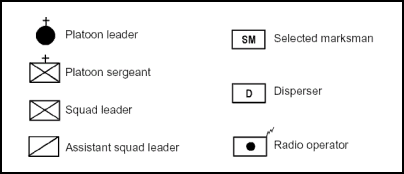
Figure B-1. Symbols for a Formation Element
B-74. The control force moves to the site of a disturbance in a column formation and then executes a riot control formation on site. To form a riot control formation from a column formation, the platoon leader moves to the right of the platoon and faces troops when giving commands. He gives the arm-and-hand signal and the preparatory command. On the execution command MOVE , he points to the approximate location where he wants the platoon to form. The platoon leader pauses between the preparatory command and the execution command to allow each squad leader to issue a preparatory command to his squad.
B-75. In a three-squad platoon, the first and third squads are usually the lead elements in formations when one squad provides general or lateral support. The support squad, when held in general support, may be in a single column or a column of twos. The following examples presume that the second squad is the support squad.
B-76. When the support squad moves from general support to lateral support or to extend the existing formation, the even-numbered members move to the right and the odd-numbered members move to the left. The squad leader usually controls the even-numbered members, and the assistant squad leader controls the odd-numbered members. To assemble the support squad from any position to general support, the platoon leader commands SECOND SQUAD IN SUPPORT, MOVE . The second squad then returns to a column behind the line formed by the other two squads.
B-77. The line formation (Figure B-2) is used the most because of its offensive and defensive applications. As an offensive formation, it is used to push or drive crowds straight back, across an open area, or up a city street. As a defensive formation, it is used to hold crowds or deny access to restricted streets or areas.
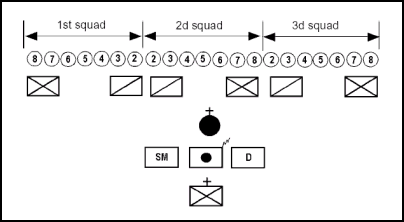
Figure B-2. Line Formation
B-78. The command for forming a platoon line is PLATOON AS SKIRMISHERS, MOVE . The second squad moves forward to the point designated by the platoon leader. The number two man of the second squad is the baseman for the platoon formation. The—
B-79. When assembling a platoon from the line formation, the platoon leader and headquarters personnel take a position to the rear of the platoon. The platoon leader gives the command PLATOON ASSEMBLE, MOVE. He raises his right arm and makes a circular motion above his head. The squad leader of the second squad commands FOLLOW ME and double-times to the designated spot. Other squad members follow the squad leader. As the second squad clears the line formation, the first and third squad leaders command FOLLOW ME and double-time toward the platoon leader, dressing on either side of the second squad. All squads halt automatically behind the platoon headquarters and dress.
B-80. The wedge formation ( Figure B-3 ) is an offensive formation that is used to penetrate and split crowds. The command for forming the platoon wedge is PLATOON WEDGE, MOVE . The second squad executes a squad wedge at the point designated by the platoon leader. The squad wedge consists of an echelon left of the odd-numbered members and an echelon right of the even-numbered members, with the baseman at the apex of the wedge. The first and third squads form echelons left and right, respectively, of the second squad.
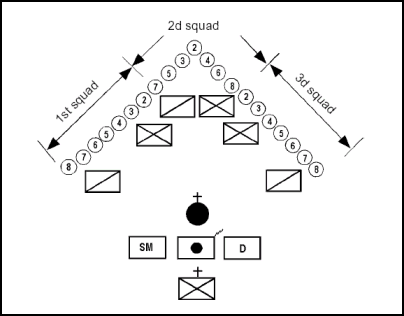
Figure B-3. Wedge Formation
B-81. Assembling from a wedge formation is similar to assembling from a platoon echelon. The second squad assembles first. On the command PLATOON ASSEMBLE, MOVE , the second squad leader moves to the point designated by the platoon leader. The second squad assembles behind the squad leader in numerical order. The first and third squads move into column formation to the left and right of the second squad, respectively, and dress on the second squad.
B-82. The echelon formation ( Figure B-4 ) is an offensive formation. It is used to turn or divert groups in open or built-up areas and to move crowds away from buildings, fences, and walls. An echelon formation can be an echelon right or an echelon left, depending on the direction in which the crowd is to be moved.
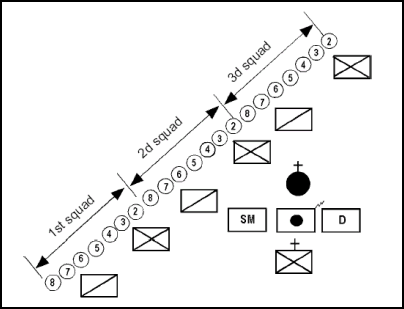
Figure B-4. Echelon Left Formation
B-83. The command for forming a platoon echelon left is PLATOON ECHELON LEFT, MOVE . The third squad baseman posts himself at the location designated by the platoon leader. Remaining squad members position themselves one step back and one step to the left of the preceding soldier. As each squad clears the column, the next successive squad moves out and extends the echelon that has been formed.
B-84. To assemble the platoon from an echelon left, the commander takes his position to the rear of the formation with the platoon headquarters. On the command PLATOON ASSEMBLE, MOVE , the third squad moves and forms a column at the point designated by the platoon leader. The first and second squads assemble in column formation to the left of and dressed on the third squad.
B-85. The command for forming a platoon echelon right is PLATOON ECHELON RIGHT, MOVE . The first squad baseman posts himself at the location designated by the platoon leader. Remaining squad members position themselves one step back and one step to the right of the preceding soldier. As each squad clears the column, the next successive squad moves out and extends the echelon that has been formed.
B-86. To assemble a platoon from an echelon right, the commander takes his position to the rear of the formation with the platoon headquarters. On the command PLATOON ASSEMBLE, MOVE , the first squad moves and forms a column at the point designated by the platoon leader. The second and third squads assemble in column formation to the right of and dressed on the first squad.
B-87. The diamond formation ( Figure B-5 ) can be used as an offensive formation or a defensive formation. It is used by riot control forces when they enter a crowd to apprehend ringleaders. The diamond formation is also useful when 360-degree security is needed.
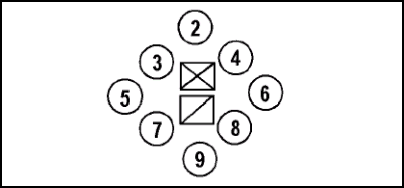
Figure B-5. Diamond Formation
B-88. The circle formation ( Figure B-6 ) is used for the same purposes as a diamond formation. It is used for dispersed and nonviolent crowds, where the diamond formation is used when the formation must break into or out of a crowd.
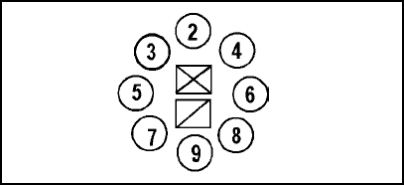
Figure B-6. Circle Formation
B-89. Many suitable variations of riot control formations can be employed. Ensure that appropriate commands and signals are devised to execute the formations. Due to their complicated nature and the coordination required, practice the formations extensively before actually using them in a riot.
B-90. Riot control formations may require enhancement. They can be very tiring and stressful for troops on line, especially when faced with a hostile crowd. The crowd may try to break through the control force to reach a protected facility or to disrupt the efforts of the control force. Likewise, a determined crowd may refuse to give way to an advancing control force if they believe the line is not solid. Other elements of the control force can be positioned in general, lateral, or close support of the main line as needed. When all the troops in the unit are not required on line at the same time, the remaining elements can be kept in general support. Elements in general support are immediately available to provide lateral or close support as the situation changes.
B-91. The command for forming a platoon formation with a squad in general support ( Figure B-7 ) is PLATOON AS SKIRMISHERS (ECHELON LEFT, ECHELON RIGHT, WEDGE), SECOND SQUAD IN SUPPORT, MOVE . The first and third squads execute the formation, and the second squad remains in column formation. The number two man of the third squad is the baseman for the formation.
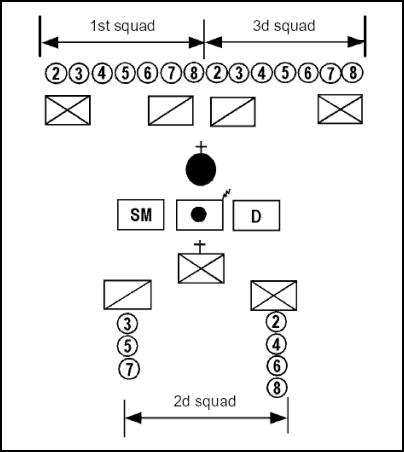
Figure B-7. Platoon Line, 2d Squad in General Support
B-92. The command for forming a platoon formation with one squad in general support in a column of twos is PLATOON AS SKIRMISHERS (ECHELON LEFT, ECHELON RIGHT, WEDGE), SECOND SQUAD IN SUPPORT IN COLUMN OF TWOS, MOVE . The first and third squads execute the formation. The second squad, at the command of its squad leader, executes a column of twos to the right.
B-93. To assemble a platoon with a squad in general support, the procedure is the same as for a formation without support, except the second squad does a countercolumn. The third squad then dresses on the right of the second squad, and the first squad dresses on the left of the second squad.
B-94. Troops deployed in lateral support ( Figure B-8 ) extend the sides of a formation and prevent access to the rear of the formation. The command for forming a platoon formation with lateral support is PLATOON AS SKIRMISHERS (ECHELON LEFT, ECHELON RIGHT, WEDGE), SECOND SQUAD IN LATERAL SUPPORT, MOVE . The first and third squads execute the formation, while the second squad stands fast. When the formation is formed, the odd-numbered members of the second squad form in column formation behind the last man of the first squad and the even-numbered members form in column formation behind the last man of the third squad.
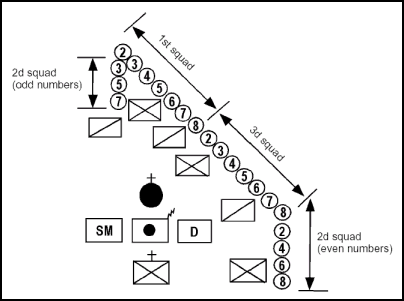
Figure B-8. Platoon Echelon Right, 2d Squad in Lateral Support
B-95. To move the second squad from general support to lateral support, the platoon leader commands SECOND SQUAD, LATERAL SUPPORT, MOVE . To have the second squad join the formation from general or lateral support, the platoon leader commands SECOND SQUAD, EXTEND THE LINE (WEDGE), MOVE . The second squad moves out—odd-numbered members to the left and even-numbered members to the right—to extend the formation of the first and third squads.
B-96. To assemble the platoon from a platoon formation with lateral support is nearly the same as for the platoon line. However, the number two men of the second and third squads do a right face and a left face, respectively, toward their squad leaders. On the execution command, the first and third squads move to the point designated by the platoon leader. As the first and third squads clear the formation, the second squad moves.
B-97. Troops in close support ( Figure B-9 ) reinforce the line to prevent the crowd from breaking through the control force. This is done by putting a second line of soldiers at a close interval behind the lead element, covering the interval between the soldiers in the lead formation.
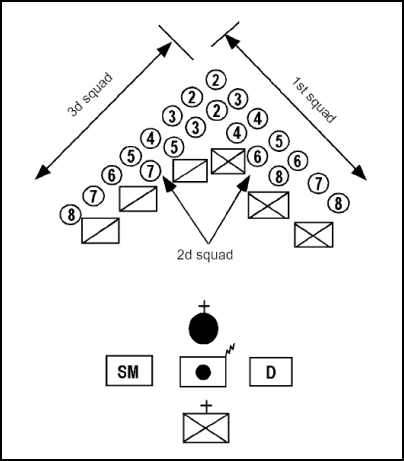
Figure B-9. Platoon Wedge, 2nd Squad in Close Support
B-98. The command for forming a platoon formation with a squad in close support is PLATOON AS SKIRMISHERS (ECHELON LEFT, ECHELON RIGHT, WEDGE), SECOND SQUAD IN CLOSE SUPPORT, MOVE . The first and third squads execute the primary formation. After the first and third squads are in position, the second squad executes the same formation to the rear of the first formation and closes in on it. The soldiers in the supporting formation shift to cover the intervals between soldiers in the first formation.
B-99. When a control force encounters large riot groups, they can employ vehicles and troops on foot in riot control formations. Employ armored vehicles when practical because they have a strong psychological effect and offer protection for occupants. Consider the following when using vehicles in riot control formations:
B-100. During riot control operations, the platoon leader may rotate squads in the lead elements of the formation to give them a rest. He is not limited to using only the squads specified in the preceding examples as the lead elements. By changing the preparatory command, he can choose other squads to lead the unit. For example, if he wants the first and second squads to lead a platoon wedge, he issues the command PLATOON WEDGE, THIRD SQUAD IN SUPPORT, MOVE . By designating the support squad in the preparatory command, the platoon leader tells the remaining squads that they will lead the formation.
B-101. The platoon leader may also relieve squads in the lead element by forming the same formation with support squads. The support element then passes through the lead element. This procedure is often necessary when soldiers don protective masks to employ riot control agents.
B-102. Commands can be given to riot control units in formation orally or with hand signals. Normally, both verbal and nonverbal commands are given. All formation commands are given in two counts—a preparatory command followed by an execution command. All movements into or recovering from riot control formations are performed at the halt.
B-103. The formation commander faces the troops and gives the preparatory oral command, accompanied by the appropriate visual command. On the execution command, the leader drops both arms and points to the position where he wants the element to form. The formation commander gives the following visual commands:
B-104. The oral rifle commands for safe port, safeguard, and on guard and the baton commands for parade rest, port, and on guard are given in one count. Do not rely on oral commands completely, especially with the added noise from vehicles, helicopters, and crowds. Plan to use alternate methods for relaying commands.
B-105. While in the assembly area, each squad leader has his squad count off. The squad leader is always number 1, and the baseman for the formation is number 2. The number each soldier is assigned during the count off determines his position in his unit's control formation. The unit marches in column formation from the assembly area to the disturbance site. It halts a reasonably safe distance from the crowd, within plain view of it. The on-site commander decides the riot control formation to use and the size of the element to commit.
B-106. On the preparatory command, troops assume the safe-port position. On the execution command, troops form the formation with the baseman posting himself at the location pointed to by the element leader. As troops reach their proper positions, they face the direction of the unit's intended advance and come to a halt. They remain halted in the safe-port position and await further orders. Once the troops are in the riot control formation, the commander commands SAFEGUARD and issues the proclamation. Following the proclamation, the commander informs disturbance participants that they have a specific time in which to comply with the order to disperse. If participants fail to disperse within the given time, the commander employs measures needed to disperse the crowd.
B-107. When a rifle-equipped formation is commanded to safeguard or on guard, the commands are for the lead element only and the support elements come to port arms. Similarly, when a baton-equipped formation is commanded to port or on guard, the general or lateral support elements assume the port position. Members of support elements give a resounding stomp with their left feet when the lead element goes to on guard. On the command FORWARD, MARCH , the support element maintains the same half step as the lead element.
B-109. The commander may increase or decrease cadence depending on the situation. For example, he may order quick time to keep pressure on a crowd that is withdrawing. He halts a formation moving in the on-guard position by commanding PLATOON (SQUAD/COMPANY), HALT . The command of execution is given on the left foot. On the command HALT , each soldier in the formation brings his right foot forward, even with his left foot, then takes one more half step with his left foot. He stomps his left foot as he comes to a halt and remains in the on-guard position.
B-110. The usual interval distance between soldiers in riot control formations is one pace or 30 inches but it can be adjusted for particular situations. A 30-inch interval may not be sufficient in some situations and may have to be lengthened. Some police forces have found that a greater interval makes formation members less vulnerable to thrown objects.
B-111. When a unit is in a column formation, each echelon commander usually takes a position at the head of the column. In riot control formations, the element leader takes a position where he can best direct and control the unit. The senior formation commander normally centers himself and his staff behind the formation. Subordinate leaders position themselves where they can best control their soldiers within the formation. For diamond and circle formations, the squad leader and the assistant squad leader place themselves in the center of the formation. These are only guidelines, and leaders can adjust positions with respect to their units as they see fit.
B-112. In column formations, messengers, radio operators, marksmen, disperser operators, and other platoon headquarters members usually take positions at the front of the column. In riot control formations, headquarters personnel can be positioned near the commander at his discretion. If the situation does not allow this, headquarters personnel can be positioned behind the control element.